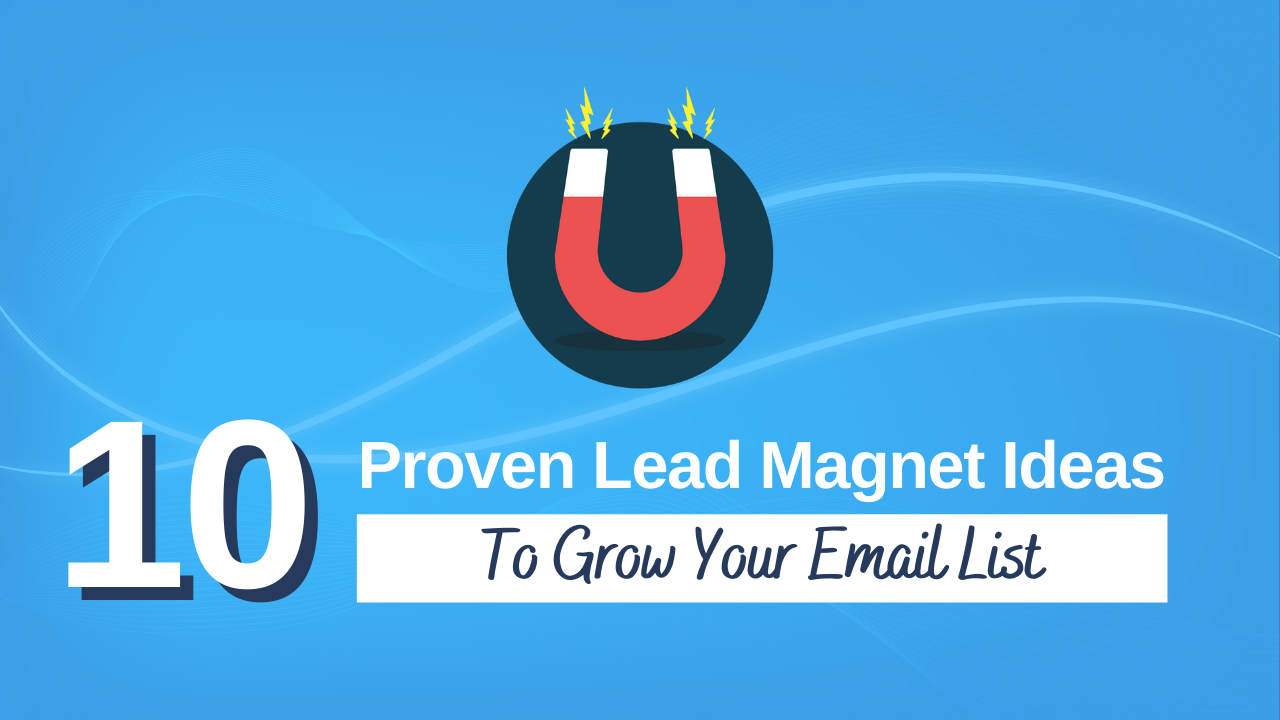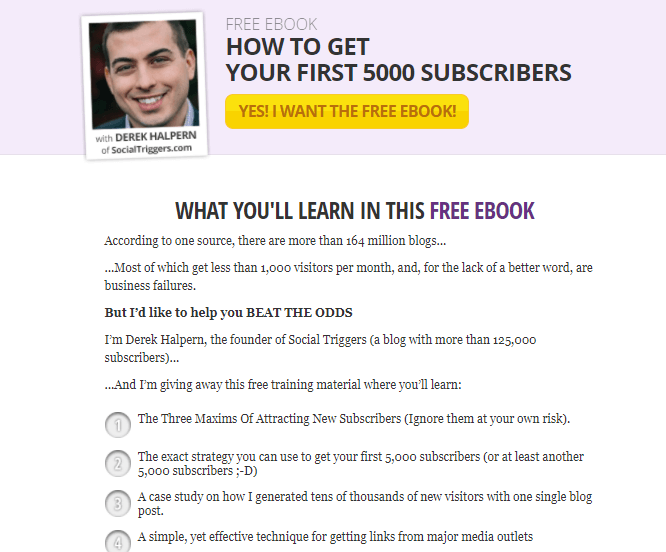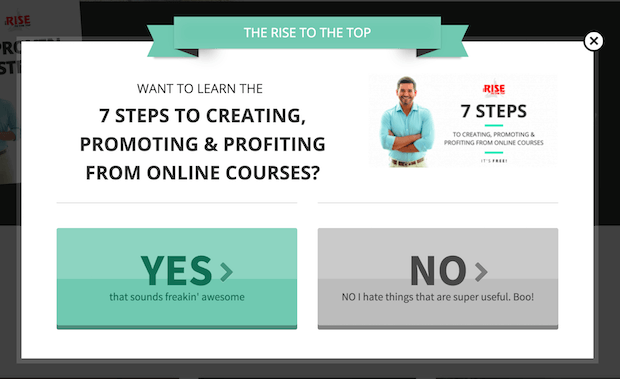
10 Proven Lead Magnet Ideas To Grow Your Email List
What is a lead magnet and how do you find great lead magnet ideas?
The answers to these questions are right here, in this blog post!
As an experienced professional copywriter and business owner, I know how important lead magnets are for online businesses. I also know how difficult it can be to find lead magnet ideas that work.
So, you’re in luck as I’ve decided to share with you 10 irresistible lead magnet examples to inspire you and help you create lead magnets that convert.
What Is A Lead Magnet?
A lead magnet is a free, valuable resource that businesses offer to their target customers to convert them into paying customers down the road.
But why would you offer free and valuable resources to people who aren’t even your customers?
Because it takes time for people who aren’t familiar with your brand or business to commit to purchasing from you.
In fact, based on research, it takes an average of 7 to 12 times for a new website visitor to purchase something from a brand. To build trust and convince your leads that they should buy your products or services, you need to nurture them.
And there’s no better way to nurture your leads and move them down the sales funnel than offering them a freebie.
Why Does Your Business Need To Use Lead Magnets?
‘’50% of marketers who start using lead magnets report higher conversion rates’’.
If you’re looking to generate leads online and grow your revenue, you need to use lead magnets.
And the reason why lead magnets are essential is that they give your potential customers a compelling reason to share their personal information.
Let’s take a look at an example.
Say you’re looking to buy a few healthy meals to lose fat and build muscle. You go to your closest health food store for the first time and start looking at their product range. Now, would you provide your email address or phone number to the salesperson in the store just because they’re asking?
Probably not.
But if the same person was to offer a free eBook with 50 easy recipes to lose fat and build muscle in exchange for your email address, what would you do?
And If you’re committed to getting in shape, you’re likely to provide your email address.
A well-thought-out lead magnet will provide your target audience with something they perceive as being of high value. And it will be so compelling that your leads won’t be able to resist.
More specifically, to convert, a lead magnet should:
- Solve a problem
- Be specific
- Be quick to read and easy to digest
- Provide high value to your target audience
- Show your potential customers that you’re an expert in your field
- Convey your unique value proposition
- Help your ideal customer achieve something
- Use power words to elicit emotions
Here are 99 power words for sales pitches to land new clients in that you can use in your lead magnets.
Once you’ve grown your email list, make sure to create winning emails to move your leads down the sales funnel. To help you, I’ve put together an article about a 9-word email that works like magic.
High-Converting Lead Magnet Ideas
Now, onto the fun part!
Here are 10 lead magnet ideas and examples to inspire you and get your creative juices flowing.
Ebooks
Offering your web visitors a free eBook in exchange for their email address can be one of the most effective lead magnet ideas if your strategy is executed correctly.
What do I mean by that?
Ebooks are classified as long-form content. Now, these days, consumers have an attention span of 8 seconds on average.
So, if you want people to be interested in reading your eBooks and give you their details, you need to solve one of their pain points.
This is a great example of an eBook lead magnet, as it offers to solve a major pain point for content creators and businesses: getting subscribers.

Ebooks
Guides
Educational lead magnets are always popular because they provide value.
And as such, guides can be perceived as high value to your prospective customers because they educate them comprehensively on a specific topic.
For instance, let’s say you run a travel agency specialising in Australian and New Zealand trips. An effective lead magnet could be ‘’The Ultimate Guide To Australia’s Great Barrier Reef’’.
While typically longer than other kinds of lead magnets, guides can effectively convert your web visitors into subscribers because they provide all the answers your audience needs in one spot.
The example below is one of the best guide lead magnet examples I’ve seen. What I like about it is that it is immediately actionable, as it provides a comprehensive set of tools to help businesses improve their inbound marketing strategy.

Guides
Workbooks
A workbook is a resource that allows participants to learn by doing. It usually consists of a document that web visitors download and complete after reading on a specific topic on your blog. It’s designed to help them apply what you’ve just taught them to their own businesses or situations.
I find workbooks to be one of the best lead magnet ideas. They’ll show your prospective customers how relevant your insights can be for their businesses and work wonders to cement you as an expert in your field.
What’s more, they’re an interactive tool you can use to engage your audience and create a deeper connection.
Here’s an example by LinkedIn offering people a free workbook to assess and improve the performance of their content creation strategy.

Workbooks
Cheatsheets
A cheatsheet is a clear and concise one-page summary of a lengthy or complex process that consumers can refer to over and over again to achieve a specific goal.
And cheat sheets are one of the best lead magnet ideas to convert your website visitors into subscribers.
Why?
Because they help your audience remember something valuable. What’s more, they’re short, easily digestible, and provide a quick answer to a problem. And that’s exactly what consumers are after in our fast-paced society.
Here’s a cheatsheet lead magnet example by Jon Morrow from Smart Blogger.
This lead magnet resonates with bloggers because they all want their blog posts to go viral. This cheatsheet offers them a quick summary of powerful headline hacks they can refer to when crafting their posts. This means that they don’t need to remember every single one of them.

Cheatsheets
Templates
Templates are extremely valuable these days because they save people a significant amount of time and hassle. Depending on the industry you’re operating in, providing your potential customers with high-quality templates can also help them look more professional in front of their clients.
And if you’re looking for great template lead magnet ideas, here’s one from Convert Kit.
It targets eCommerce websites and online businesses that want to build their email lists with a well-designed landing page.
Now, if you were looking to boost your leads and revenue through the creation of landing pages, you’d probably say yes to a free professional landing page template in exchange for your email address, right?
I know I would 😉

Templates
Plans or Planners
If you want to create added value for your audience, creating and sharing free planners, monthly plans, or even a calendar template could be a great idea.
Still in the spirit of saving your audience time and hassle, plans and planners will help your potential customers stay organised and achieve their goals without having to think or do any research. That’s why, if you create the right plan or planner, your potential customer won’t be able to resist.
Here are some great plans and planners lead magnet ideas:
3 meal plans for busy professionals and mums who don’t have time to think about what to cook for dinner
3 workout programs for muscle building, fat loss, and sports performance
Content planners to help business owners be consistent and organised

Plans or Planners
Reports
Reports are one of the best lead magnet ideas if you work with B2B clients. They usually provide statistics, data, research, or a collection of all of these in a comprehensive document.
And the great thing about using reports as lead magnets is that they’re easy to create. If you don’t have the data yourself, you can compile valuable insights you know will resonate with your audience from trusted sources and create a comprehensive report.
Here’s a compelling report lead magnet example highlighting why YouTube is a great source of traffic.

Reports
Tutorials
Tutorials teach people how to do something in a compelling way and use an easy-to-digest format such as a PDF or a video. They’re extremely popular because they’re an easy way for consumers to learn about a topic and reach their goals.
And for your tutorial lead magnets to convert, highlight how many steps the tutorial entails and keep it short.
The example below is one of my favorite lead magnet examples. It is designed to make it easy for web visitors to understand what the tutorial encompasses.
But more importantly, the headline makes it hard to resist for people who want to monetize their skills or knowledge by creating an online course.

Tutorials
Free Discovery Call
One of the lead magnet ideas I've been using for a while is the free discovery call.
Whether you're a coach, a photographer, or a software company, a discovery call is a proven way to win the trust of your potential customers.
A discovery call will allow you to introduce yourself and show them how great your product is. But you'll also collect precious information about your potential buyers' pain points and needs. This means you can then tailor content specifically to them.
Free Shipping
Ever shopped online for a specific product only to end up exiting the website at checkout due to shipping fees?
If you sell tangible items, free shipping can be the little nudge your potential customers need to make the purchase.
So, offering free shipping for a limited time can be a fantastic way to convince web visitors to purchase from you.

Free Shipping
How To Create A Lead Magnet That Resonates With Your Customers?
You could use lead magnet templates available on the internet. However, if you opt for this solution, be aware that other brands are doing the same. This means that you’re running the risk for your target audience to have seen the same lead magnet template on one of your competitor’s websites.
Now, in my experience, using a generic lead magnet is rarely successful. These days, consumers expect authenticity, creativity, professionalism, and more than anything, personalisation.
So, if you want to wow your target audience, you need to craft unique high-impact lead magnets that will capture their attention and immediately turn them into subscribers.
And as a professional copywriter with years of experience under his belt, I can only encourage you to work with a professional copywriting agency to create compelling lead magnets.
At CopywritingCrew, we combine a passion for copywriting and a knack for creativity to craft high-converting lead magnets. Over the years, my team and I have designed hundreds of lead magnets for clients, helping them turn website visitors into engaged subscribers.
So, if you want to increase your leads, don’t hesitate to get in touch with me to discuss your upcoming lead magnet campaign. Alternatively, you can also order from our opt-in page service.
Frequently Asked Questions About Lead Magnets
Question: Why Should You Try Different Types of Lead Magnets (If You Haven't Yet)?
Answer: Research indicates that businesses can benefit from using 15+ different lead magnets. That’s because creating multiple lead magnets will allow you to appeal to customers at different stages of their buying journey.
Plus, you might sell different products or services and cater to different customer types, requiring multiple lead magnets.
Question: Are Lead Magnets Worth It?
Answer: Lead magnets are an excellent way to build a bridge between the awareness stage of the customers’ buying journey and the trust and likeability stage.
By providing something of value for free, you’ll build trust with your target audience. And as your potential customers share their personal details with you, you’ll be able to create personalised content and offers that resonate with them and turn them into loyal customers.
Question: When Should You Use Lead Magnets?
Answer: Lead magnets are a great tool to use if you want to:
- Grow your email list
- Nurture your qualified leads
- Increase your revenue
Further Reading
We hope you found the lead magnet ideas listed in this blog post useful.
Here are some further resources on copywriting tips that can help boost your leads and traffic:
- 5 SEO Content Writing Tips You Should Know
9 Copywriting Secrets To Boos Your Traffic And Sales



















